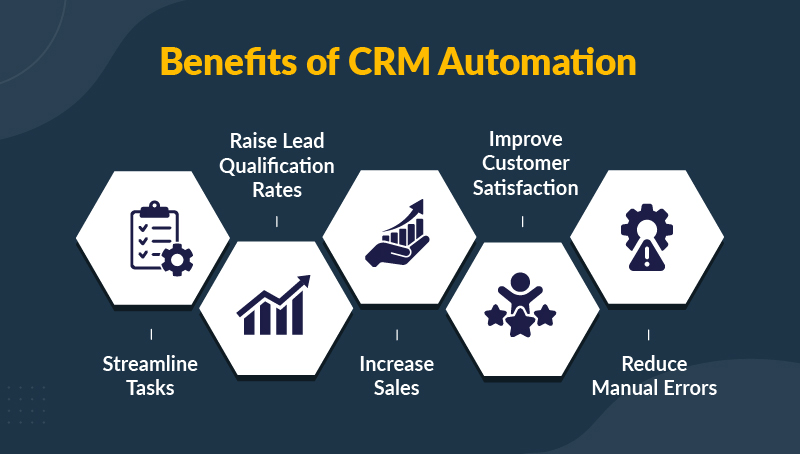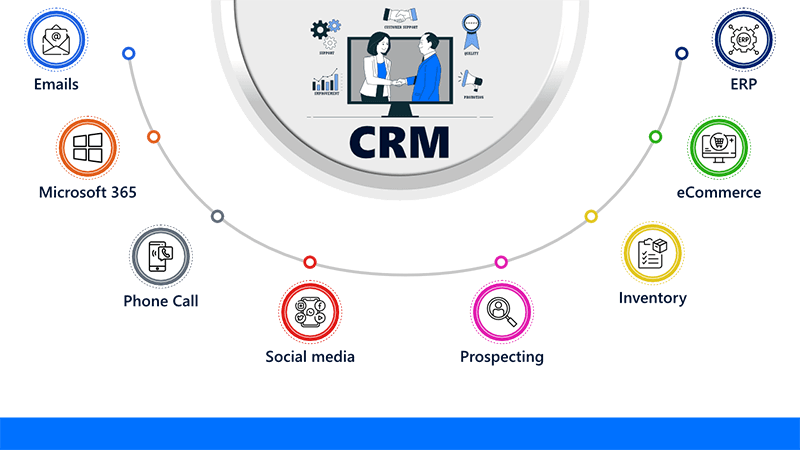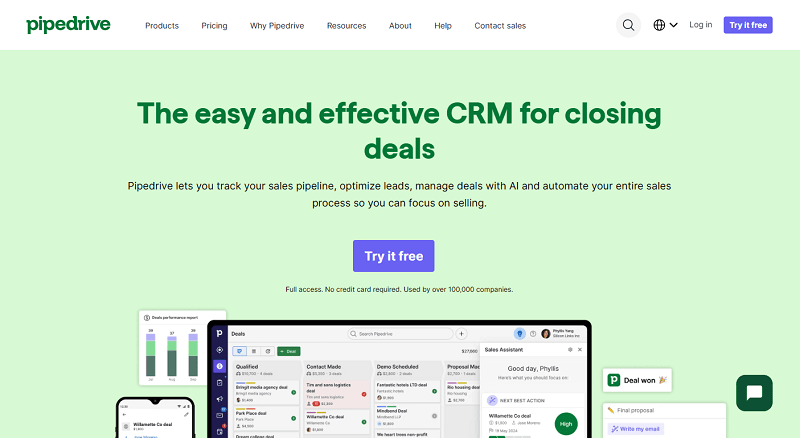Selecting the right customer relationship management (CRM) software can be challenging, especially for a newbie. Many CRM software choices are available, but some may lack good data organization, integration management, and cost-effectiveness.
When selecting a CRM for your company, it is crucial to take your time. You need to ensure that you make the best decision because it will have a significant impact on your operations. This means companies need to plan the CRM selection process far ahead of time. Before diving into the selection process, let’s look at the meaning of CRM.
What is a CRM?
CRM stands for customer relationship management. A complete software system that manages customer relationships and drives revenue. CRM software gathers, links, and analyzes all collected customer data.
It supports strong, productive, and loyal customer relationships through informed and superior customer experiences. Above all, the goal is to improve customer service, build relationships, increase customer retention, and drive sales.
| The Importance of CRM in Business | |
|---|---|
| Automates repetitive sales, marketing, and customer service processes | |
| Promotes inter-departmental collaboration | |
| Tracks prospects and customers through their purchase journey | |
| Centralizes customer information | |
| Enhances communication across team members | |
| Ensures efficient handling of inquiries and issues | |
| Facilitates follow-ups and leads nurturing | |
| Tracks marketing effectiveness | |
| Integrates with other business tools | |
| Gathers comprehensive customer data |
Examples of Popular CRM
The Best Overall
Pipedrive
A sales-focused CRM that leverages AI to automate sales, lead & demand generation.
Best Budget Choice
Freshsales
Freshsales automates your sales process, and helps drives sustainable business growth.
Best for Workflows
Zendesk
Customize your workflows to track all aspects of the sales cycle, from lead gen to post-sale support.
Essential Features to Look Out for When Selecting a CRM
1. Robust Automation Features
Your salespeople’s time spent on repetitive duties like data entry, emailing, and creating follow-up reminders can be detrimental. Furthermore, human error is a risk in any manual procedure, resulting in lost sales opportunities and dissatisfied clients.
CRMs can automate tasks, use email templates, and send notifications to save time, reduce errors, and increase productivity. Most importantly, you purchase CRM software that is simple to use and functional.

2. Essential Integration
In the past, CRM integration was only used for customer management after the sale. Nevertheless, CRM integration has evolved past its initial function, becoming a wholly integrated marketing, sales, and customer support platform. Thousands of plug-ins and app connections are available for many CRM packages, which increase functionalities. You may freely share data and link your CRM to the necessary business tools you now use via add-ons and API connections.
Keep an eye out for the following crucial integrations in any CRM program you choose:

• Email Marketing Integrations: Users can keep an organized list of their clients’ email addresses in their CRM software. Representatives may assist customers by accessing their information, past interactions, and purchase history when they call your firm.
• Social Media Integrations: This connection allows you to easily manage customer inquiries and interactions across different social media channels.
- Connect your social media accounts to your CRM system to make customer service faster and more efficient. This integration also enables you to track customer interactions and gather valuable data for better understanding customer needs.
- It also allows you to manage customer interactions across different platforms in one place. This integration ultimately improves your customer service experience. You can also use CRMs for social media account management.
• Web Analytics: By integrating your CRM with web analytics software, you can gather and examine information about website visitors. You’ll gain knowledge that will enable you to make wiser choices.
• More integrations are available for CRM solutions, with some being more client-focused to fit your company’s needs. Some CRMs can connect with ERP software, HR software, business intelligence apps, and top business phone systems.
3. Lead Management
Lead management is an important tool for sales teams in CRM. It helps them track and follow up with potential clients. This is accomplished by using criteria such as financial, psychographic, and demographic information. Lead scoring helps sales teams focus on potential customers most likely to buy, making lead management more efficient.
4. Contact Management
One vital component of CRM is contact management. With the top CRM tools, you can manage all your contacts and customer information in one place. Additionally, they facilitate contact segmentation, which facilitates targeting and connecting with particular target audiences.
Contact management involves obtaining and appending more client data to a contact’s record to enhance your marketing approach. Detailed data helps you connect with customers by customizing interactions based on their expectations, experiences, and other information.
CRM Selection Process
Selecting a customer relationship management (CRM) system is necessary for any business. Hence, companies should use a logical approach to ensure they get the best CRM vendor for their company.

A. Define Your Business Goals
Before selecting CRM software, map out your goals and expectations. This will save you from being confused.
Firstly, list the challenges you’re facing with the present system and focus on the areas you want to change or improve. This will guide you in identifying the features to look for. Ask and answer these questions:
• What are my goals?
• Can the CRM platform grow my business?
• How customizable is the system?
• Is the CRM scalable?
B. Set a Budget
Determining your budget while selecting a CRM system is vital. CRM software can be free or expensive, with basic or advanced features. When setting your budget, note the following points:
• Initial setup costs vary for different CRMs, some require upfront payment while others charge a monthly subscription fee.
• Scalability: Can the CRM grow with your business? Consider future costs as you add more users or require advanced features.
• Hidden Costs: Consider additional costs such as customization, training, and support.
C. Choose a Deployment Method: Cloud vs. On-Premise
After setting your budget, decide whether you want a cloud-based or on-premise CRM.
A Cloud CRM allows access from any device. It allows you to easily access real-time data and automate tasks such as qualifying leads and enhancing customer relationships.
• Pros:
• Cloud-based CRMs are cheaper upfront because they operate on a subscription model. which means you don’t have to spend as much money on hardware and software.
• Ease of implementation: The vendor handles setup, maintenance, and updates, which can benefit businesses with limited IT resources.
• Scalability: Easily scalable to accommodate growing businesses. You can add or remove users as needed without significant hassle.
• Accessibility: Accessible from anywhere with an internet connection, making it ideal for remote teams and businesses with multiple locations.
• Regular updates: Businesses regularly get updates on cloud-based CRM. This ensures they have access to features without requiring effort from their IT team.
• Reduced maintenance: The vendor handles maintenance and troubleshooting, freeing your internal IT resources for other tasks.
• Cons:
• Data control: Since the vendor stores data on their servers, there is less control over it. This can concern businesses with strict data security and compliance requirements.
• Subscription costs: While the initial costs are lower, subscription fees can increase over time, especially as you scale.
• Internet dependency: Relies on a stable internet connection. Any downtime can impact accessibility and productivity.
• Limited customization: Some cloud-based CRMs offer limited customization options compared to on-premise solutions.
- On-Premise CRM Software: On-premise CRM is software installed and hosted on servers. The business is responsible for all aspects of the CRM.
Pros:
• Data control and security: Your business will have full control over data and security, important for protecting essential information.
• Customization is possible with on-premise CRM. This allows businesses to adjust the system to fit their specific needs. It also makes it easy to integrate with existing on-premise systems.
• You don’t have to pay monthly fees. Once you make your initial investment, you won’t have to pay any more subscription fees. This will save you money in the long run.
• Operational efficiency: This requires businesses to pay for hardware.
Cons:
• Higher upfront costs: Applying on-premise requires substantial payment.
• Maintenance: Your business must handle all maintenance, updates, and security for on-premise CRM. This requires a highly skilled professional team.
• Growing a business with on-premise systems is hard because it needs more hardware and software, which costs a lot.
• Implementation time: Implementation can be time-consuming, requiring significant planning and resources.
When deciding on a CRM deployment method, consider how it aligns with your business goals and available resources. Consider the different options available and how they fit with what you want to achieve. Make sure to assess your organization’s needs and capabilities before making a decision. Choosing a CRM deployment method that will help you reach your goals effectively is important.
D. Evaluate User-Friendliness
Evaluating user-friendliness is crucial when selecting a CRM because a system that is difficult to use can lead to poor adoption rates, reduced productivity, and frustration among employees. Here are detailed considerations to help you assess the user-friendliness of a CRM:
• Request a Demo: When you request a demo, a salesperson will guide you through the product’s functionality. This allows you to see how intuitive the system is and how easily you can navigate different features.
• Request Free Trials: Requesting free trials is a crucial step in evaluating a CRM system’s user-friendliness. It helps you understand the pros and cons of your potential CRM.
• Gather feedback from users by having team members from different departments complete tasks. These tasks include adding contacts, updating leads, and creating reports. After they’ve finished, collect their feedback through a survey.
By listening to user feedback, you can better decide if the CRM will help your team boost productivity. This approach focuses on the user, making sure the chosen CRM works well for your team. Which leads to higher adoption rates and smoother integration into your business.
E. Make a Decision
After gathering all the necessary information, the next step is to decide on the CRM solution that best suits your business needs. That includes comparing all the CRMs you’ve chosen to your needs and the feedback from your team during testing.
When selecting the right CRM, consider how it integrates with your current systems. Also, think about the cost of the CRM. Additionally, evaluate CRM if it can scale with your business as it grows. Lastly, assess the level of support provided by the vendor. Once a decision is made, communicate it to all team members to ensure everyone is on the same page.
F. Plan for Implementation
The last step is the implementation. This plan should describe the steps for deploying the new CRM system into your business. The plan includes:
• Setting up the system
• Migrating existing data
• Configuring the CRM to align with your business processes
• Integrating it with other essential tools and systems
Assign a project manager or a dedicated team to oversee the implementation. That will ensure all tasks are completed on schedule and all issues are promptly addressed. By making a well-informed decision and planning for implementation, you can ensure a smooth transition to the new CRM system, enhancing efficiency and better customer relationship management.
Benefits of CRM Selection Process

Investing in a proper CRM selection solution is necessary for every business that wants to take customer satisfaction to another level. CRMs generally offer good benefits; however, selecting the right one will give you the best results. Here are the key benefits:
• Aligning Business Needs: This alignment ensures that the preferred CRM solution addresses the business’s unique needs, whether improving customer service, enhancing sales processes, or streamlining marketing efforts.
• Enhanced User Adoption: A well-executed CRM selection process considers usability testing; it ensures that the selected CRM is intuitive and easy for employees to use. Higher usability leads to increased user adoption rates, as employees are more likely to embrace and effectively utilize the CRM in their daily tasks.
• Cost Efficiency: Proper evaluation of CRM systems helps identify the total cost of ownership, including implementation costs, ongoing maintenance, and potential return on investment (ROI).
Organizations can select a CRM solution that offers the best value for money and aligns with budget constraints.
• Improved Customer Insights: Implementing a CRM selected through a planned process allows organizations to gather and analyze valuable customer data more effectively. This data enables a better understanding of customer behaviors, preferences, and needs, which leads to more targeted marketing campaigns and personalized customer interactions.
• Scalability and Flexibility: This flexibility allows for seamless integration with new technologies and adaptation to changing business environments.
• Efficient Implementation: CRM selection process includes detailed implementation planning, outlining steps, timelines, and responsibilities for deploying the CRM. The above approach minimizes disruptions to business operations, reduces implementation risks, and facilitates a smoother transition to the new system.
• Continuous Improvement: Post-implementation reviews and ongoing monitoring of CRM performance are integral parts of a structured selection process. A continuous improvement process allows organizations to refine CRM strategies, optimize workflows, and enhance customer relationship management over time.
Mistakes to Avoid When Choosing a CRM

When selecting a CRM, it is needful to note common mistakes:
• Lack of Clear Objectives: It’s important to have goals before selecting a CRM for your business. Define what you want to achieve with the CRM, With clear goals and objectives, finding a CRM that will meet your business needs will be easier.
• Failing to Do Enough Research: Choosing a CRM is a significant decision for an organization, so it’s important to do as much research as possible before making a decision. Take time to learn about the wide range of CRM available to you.
• Not Considering Long-Term Goals: It’s very easy to get overwhelmed by the wide range of CRMs available, but if you fail to consider your long-term goals, you might regret it later.
A CRM that fits your current needs might not be capable of supporting your business as it grows. If your company expands in terms of customers, employees, or operations, the CRM must be able to handle the increased volume and complexity.
• Choosing Based on Price: While budget considerations are important, choosing a CRM based only on its initial cost can result in hidden expenses, limited functionality, and inadequate support, ultimately hindering your business process.
Understanding the entire pricing structure, including recurring fees, is essential to avoid surprises.
Conclusion
Selecting the right CRM is crucial for maintaining a smooth relationship with clients. It’s a strategic move that can significantly impact your business’s efficiency and growth. By carefully defining your business needs, setting a clear budget, choosing a deployment method, and evaluating features, you can ensure that the CRM you choose will be a powerful tool for managing customer relationships and driving sales.
Investing time and effort into selecting the right CRM will pay off in streamlined operations, better customer interactions, and increased profitability. So, explore your options and choose a CRM to propel your business toward tremendous success.

































